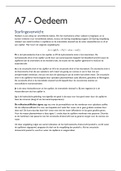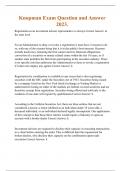Inventory and Production cycle
Introduction
Internal cycle, as there are no connections with other parties outside the entity
Only applicable to entities selling products
Supporting documents
Production plan- Based on sales forecasts and inventory currently on hand; informs the factory about the finished goods
that need to be produced
Production schedule- normally used in process costing system- shows the quantities of items that need to be produced
in the factory, and details of e.g. how many hours are needed
1. Storage of raw materials
Objective
Transfer and safekeeping of raw materials
Controls
1. Warehouse must have proper physical controls e.g. a solid structure and environmental controls
2. Proper access and security controls should be implemented, like restricted entry (biometric access), surveillance
cameras and security guards
3. Warehouse manager should perform independent cycle counts and reconcile the actual inventory on hand to recorded
quantities, to ensure the accuracy of the records and to identify theft
4. Warehouse should consist of different sections: receiving section, raw material store and finished goods store
2. Production planning
Objectives
Entity manufactures saleable inventory (A)
Entity manufactures sufficient inventory to meet demand (O)
Controls
1. Production department personnel ( system) prepare a production plan with outputs on it- how many outputs the entity
wants to produce (based on forecasts, past sales, orders, budgeted sales, pre-set conditions etc.)
2. Senior in production department (production manager) reviews and authorises production plan (2 copies; filed at
production department (for review) and to factory (to know what to manufacture))
3. Factory manager prepares a production schedule/ job order based on the authorised production plan (Schedule can be
hourly, monthly etc. based on amount produced)
4. System automatically prepares a production schedule based on the authorised plan- processing controls implemented
5. Copy of schedule sent back to production department, where production manager reviews schedule against the plan,
and authorises it to ensure only authorised production takes place
6. Copy of production schedule is filed at the factory to match with other supporting documentation like the raw materials
requisition.
7. Factory personnel prepare a raw material requisition based on the quantities requires in the production schedule
8. The factory manager reviews the RMR by agreeing it to the production schedule, and authorises it
9. Factory personnel send the pre-numbered RMR to the warehouse to release the raw material that is delivered, based
on the schedule (Two copies- filed, and sent to warehouse)
3. Transfer of raw materials to production
Objectives
Raw materials transferred match those requested (O)
Raw materials not damaged (A+C)
All transfers recorded accurately (A+C)
All transfers are valid
, Controls
1. Warehouse clerk fills out a raw materials transfer note (automatic generation based on RMR) when the inventory is
sent to the manufacturing department
2. Store manager compares the RMTN to actual goods transferred, as well as to the RMR
3. Three copies of RMTN: Filed sequentially, one to factory, 3 rd copy if perpetual inventory system to accounting
department
4. Inventory receiving clerk at the factory receives RMTN, and inspects goods for quality, quantity and description and
compares them to the RMTN, and signs as proof of review (Risk of factory receiving raw materials that are of inferior
quality or wrong description, slowing down production)
5. Inventory clerk records the transfer of the raw materials on the perpetual inventory system in a transfer journal (input
and processing controls to ensure complete and accurate recording)
6. RMTN should be sequentially pre-numbered, and the accountant should regularly review to check for any gaps in
sequence
7. Accountant reviews RMTN for accuracy and completeness, and should also review the recording on the inventory
system to ensure it has been recorded accurately, and that a RMTN exists for each order
4. Production
Objectives
No theft of inventory takes place during manufacturing, and spillage is minimalised (V)
Need to ensure that inputs reconcile with the outputs, and that FG are up to standard
FG produced agree to planned production – production report
Controls
1. Factory manager must oversee process to ensure that quality controls are implemented, to mitigate risk of spillage,
loss etc- supervision most important control
2. Factory subject to proper physical and access controls, similar to warehouse
3. Factory personnel prepare production reports, with details of all the inventory that was manufactured during a certain
period. (2 copies; Filed and sent to production department)
4. Factory manager compares the production reports to the with the RMTN to detect spillage and theft
5. Production manager compares production plans with production reports, to ensure all planned manufacturing did take
place
6. A senior manager should review and approve all reports
5. Transfer of finished goods to finished goods warehouse
Objectives
To control the finished goods transferred to the finished goods warehouse
FG not damaged, and only finished goods transferred (V+C)
Transfer of FG appropriately recorded (C+A+V)
All finished goods produced needs to be transferred (not based on someone requesting it)
Controls
1. Factory personnel prepare a finished goods transfer note (3 copies; Filed a factory, to FG warehouse, to accounting to
update records)
2. Factory foreman compares the FGTN to the actual goods transferred for quality, quantity and description
3. Finished goods storemen at the warehouse inspect, compare and agree the quality, quantity and description of the
goods received to the FGTN, and sign the FGTN as evidence of receipt and review (filed in factory)
4. Inventory clerk records the transfer in a journal by debiting finished goods and crediting WIP
5. Accountant reviews the recording for accuracy and completeness, and ensures that FGTN exist for all recorded
transfers for validity
6. FGTNs should be pre-numbered, and the accountant should regularly review for gaps in sequence
6. Storage of finished goods
1. Finished goods store clerk/manager reviews the FGTN, and checks that the quality and quantity of actual goods matches
with the note, and signs
* (Same as storage of Raw materials)
Introduction
Internal cycle, as there are no connections with other parties outside the entity
Only applicable to entities selling products
Supporting documents
Production plan- Based on sales forecasts and inventory currently on hand; informs the factory about the finished goods
that need to be produced
Production schedule- normally used in process costing system- shows the quantities of items that need to be produced
in the factory, and details of e.g. how many hours are needed
1. Storage of raw materials
Objective
Transfer and safekeeping of raw materials
Controls
1. Warehouse must have proper physical controls e.g. a solid structure and environmental controls
2. Proper access and security controls should be implemented, like restricted entry (biometric access), surveillance
cameras and security guards
3. Warehouse manager should perform independent cycle counts and reconcile the actual inventory on hand to recorded
quantities, to ensure the accuracy of the records and to identify theft
4. Warehouse should consist of different sections: receiving section, raw material store and finished goods store
2. Production planning
Objectives
Entity manufactures saleable inventory (A)
Entity manufactures sufficient inventory to meet demand (O)
Controls
1. Production department personnel ( system) prepare a production plan with outputs on it- how many outputs the entity
wants to produce (based on forecasts, past sales, orders, budgeted sales, pre-set conditions etc.)
2. Senior in production department (production manager) reviews and authorises production plan (2 copies; filed at
production department (for review) and to factory (to know what to manufacture))
3. Factory manager prepares a production schedule/ job order based on the authorised production plan (Schedule can be
hourly, monthly etc. based on amount produced)
4. System automatically prepares a production schedule based on the authorised plan- processing controls implemented
5. Copy of schedule sent back to production department, where production manager reviews schedule against the plan,
and authorises it to ensure only authorised production takes place
6. Copy of production schedule is filed at the factory to match with other supporting documentation like the raw materials
requisition.
7. Factory personnel prepare a raw material requisition based on the quantities requires in the production schedule
8. The factory manager reviews the RMR by agreeing it to the production schedule, and authorises it
9. Factory personnel send the pre-numbered RMR to the warehouse to release the raw material that is delivered, based
on the schedule (Two copies- filed, and sent to warehouse)
3. Transfer of raw materials to production
Objectives
Raw materials transferred match those requested (O)
Raw materials not damaged (A+C)
All transfers recorded accurately (A+C)
All transfers are valid
, Controls
1. Warehouse clerk fills out a raw materials transfer note (automatic generation based on RMR) when the inventory is
sent to the manufacturing department
2. Store manager compares the RMTN to actual goods transferred, as well as to the RMR
3. Three copies of RMTN: Filed sequentially, one to factory, 3 rd copy if perpetual inventory system to accounting
department
4. Inventory receiving clerk at the factory receives RMTN, and inspects goods for quality, quantity and description and
compares them to the RMTN, and signs as proof of review (Risk of factory receiving raw materials that are of inferior
quality or wrong description, slowing down production)
5. Inventory clerk records the transfer of the raw materials on the perpetual inventory system in a transfer journal (input
and processing controls to ensure complete and accurate recording)
6. RMTN should be sequentially pre-numbered, and the accountant should regularly review to check for any gaps in
sequence
7. Accountant reviews RMTN for accuracy and completeness, and should also review the recording on the inventory
system to ensure it has been recorded accurately, and that a RMTN exists for each order
4. Production
Objectives
No theft of inventory takes place during manufacturing, and spillage is minimalised (V)
Need to ensure that inputs reconcile with the outputs, and that FG are up to standard
FG produced agree to planned production – production report
Controls
1. Factory manager must oversee process to ensure that quality controls are implemented, to mitigate risk of spillage,
loss etc- supervision most important control
2. Factory subject to proper physical and access controls, similar to warehouse
3. Factory personnel prepare production reports, with details of all the inventory that was manufactured during a certain
period. (2 copies; Filed and sent to production department)
4. Factory manager compares the production reports to the with the RMTN to detect spillage and theft
5. Production manager compares production plans with production reports, to ensure all planned manufacturing did take
place
6. A senior manager should review and approve all reports
5. Transfer of finished goods to finished goods warehouse
Objectives
To control the finished goods transferred to the finished goods warehouse
FG not damaged, and only finished goods transferred (V+C)
Transfer of FG appropriately recorded (C+A+V)
All finished goods produced needs to be transferred (not based on someone requesting it)
Controls
1. Factory personnel prepare a finished goods transfer note (3 copies; Filed a factory, to FG warehouse, to accounting to
update records)
2. Factory foreman compares the FGTN to the actual goods transferred for quality, quantity and description
3. Finished goods storemen at the warehouse inspect, compare and agree the quality, quantity and description of the
goods received to the FGTN, and sign the FGTN as evidence of receipt and review (filed in factory)
4. Inventory clerk records the transfer in a journal by debiting finished goods and crediting WIP
5. Accountant reviews the recording for accuracy and completeness, and ensures that FGTN exist for all recorded
transfers for validity
6. FGTNs should be pre-numbered, and the accountant should regularly review for gaps in sequence
6. Storage of finished goods
1. Finished goods store clerk/manager reviews the FGTN, and checks that the quality and quantity of actual goods matches
with the note, and signs
* (Same as storage of Raw materials)










